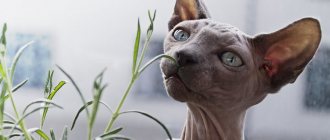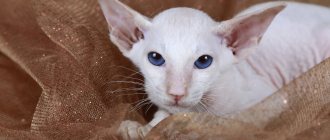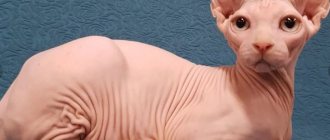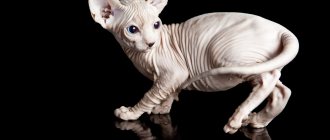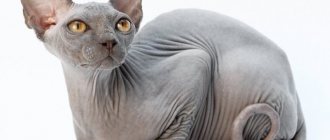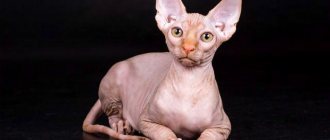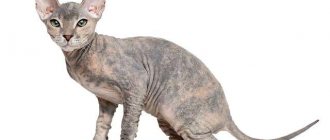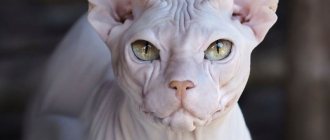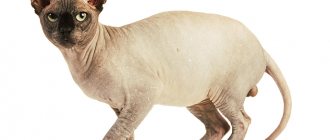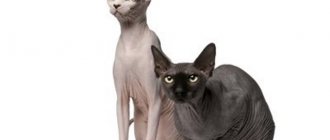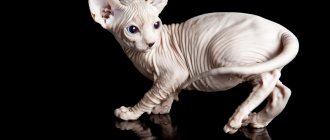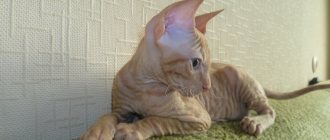Peterbalds, or St. Petersburg Sphynxes, were bred relatively recently, but have already achieved a certain popularity among lovers of the Sphynx breed. The basic standards for Peterbald were adopted in 1996. Among well-known circles, fame about the new breed quickly spread, which allowed the Peterbald to occupy a certain level of leadership among the most popular lists of breeds.
This cat breed is both similar to the original Sphynx and completely different from it.
The St. Petersburg Sphynx is characterized by grace and elegance, which are uniquely intertwined in one breed. There are definitely similarities between the Oriental and the Don Sphynx, which makes this breed an interweaving of playfulness, disposition, curiosity and a unique character in one bottle.
Origin story
Peterbald - sheer elegance and grace - was bred by Russian breeders relatively recently: in 1994. So their story is simple and has no centuries-old mystery. The second name of the Peterbald is the St. Petersburg Sphinx.
This, so to speak, is a 100% selective “product” resulting from the mixing of two well-known breeds: the Don Sphynx of Afinogen and the oriental cat Radma. The first experiment was carried out in 1994 by felinologists from St. Petersburg Tatyana Komarova and Olga Mironova.
In the first two litters, the original kittens were selected: Nocturne, Nezhenka, Muscat and Mandarin. From their father they adopted the lack of fur and the shape of the body, and from their mother - their Asian character. The kittens were included in the stud books and they became the first officially recognized ancestors of the currently existing Peterbalds.
The new breed quickly gained universal recognition. Permission for breeding was given by the Selective Felinological Federation (in 1996), soon the International Cat Association joined it (giving the breed the abbreviation PD), and finally, the animals were recognized by the World Cat Federation (2003).
At the moment, matings between “Petersburgers” and Don Sphynxes are prohibited. Feline specialists pay more attention to the external characteristics of the breed, but they do not plan to breed exclusively “hairless” cats. Maximum breed traits from Orientals and Siamese - that is their task.
“Peterbald” consists of two words: “peter” - Peter and “bold” - bald. As the breeder Olga Mironova explains, the name was invented thanks to the monument to Peter the Great (authored by Shemyakin): the first All-Russian Emperor is compared to a hidden, wary cat.
Despite the keen interest in the breed among cat people and constant participation in European exhibitions, few Peterbalds have been bred so far.
Kitten price
It is necessary to purchase a kitten only from professional nurseries at least three months old. A veterinary passport is required. Today, the sale of the St. Petersburg Sphynx is carried out by numerous breeders from different cities of Russia.
The cost of an animal varies widely depending on the purpose of purchase. You can buy a Neva Sphynx as a pet for ten thousand rubles. The price of a pet for professional breeding or exhibition work will be significantly higher.
Photo gallery of Peterbald and some other types of sphinxes:
1111
Standards
The appearance of Peterbalds is more refined and graceful than that of Sphynxes. The latter weigh 5-7 kg, while Peterbalds weigh a maximum of 5.
| Standard | Description |
| Head | Wedge-shaped, with a long and narrow muzzle. The profile is slightly convex, the forehead is flat. |
| Nose | Straight, long. |
| Eyes | Set obliquely, almond-shaped. The color of the iris is most often green, but blue is also allowed for the point color. They are spaced widely (according to the standard, one more eye can fit between them). |
| Body | Muscular and long, the silhouette is graceful. Same neck. The chest is narrower than the hips. |
| Paws | Long and thin, straight, lean. The front ones are slightly shorter than the rear ones. The pads are oval, elastic, the fingers are flexible (“monkey”). |
| Tail | Long and thin, the tip is pointed, whip-like. |
| Vibrissae | Broken-crimped or completely absent. |
| Ears | Large and tall, set wide apart, protruding beyond the cheek line. The tips are pointed. |
| Leather | Soft, forms numerous folds. There are fewer folds on the body than on the head. |
| Wool | Most often it is completely absent. On some individuals it grows very sparsely and short. |
The following types of Peterbalds are distinguished:
- Hairless cats (“gum cat”, “gummi”, classic type). You won’t find a single hair on their bodies, and their skin feels like thin rubber and is covered with a thin layer of natural brown lubricant.
- Flock. There is fur, but it is very short - up to 2 mm. Silky and pleasant to the touch.
- Velor. The coat is short or semi-long. It often disappears as the animal grows, leaving only furry “socks” at the bottom of the paws.
- Brush point. The body is covered with hair, as is the tail, but over time the body becomes bald, but the tail, paws and muzzle do not.
Peterbalds also have intermediate species (velor point, flock point, etc.), however, as the animal matures, it can change significantly in appearance. This is a significant problem, because it is impossible to guess what your pet will look like in six months or a year.
The disadvantages of the breed are: round and heavy body; crooked paws; underdeveloped chin; significant defects of the muzzle and skull; bend of the back of the nose.
If a Peterbald has strabismus or tail defects, or if the cat is aggressive, it is not allowed to compete.
In the photo there are kittens of the Peterbald breed
Coat Variations
Only the Peterbald has such a variety of skin and coat varieties. In one litter, kittens of absolutely all types can be born:
- Brush. They are born with little fur. As they grow older, the fur disappears in some areas, while the rest are evenly covered with hair.
- Brush point. At birth, the kitten is covered with thicker hair, the muzzle and tail are completely pubescent. In an adult animal, fur remains on some parts of the head, paws and tail. The rest of the body is covered with a delicate short flock.
- Velours. At birth, a kitten has long hair on its face, paws, and tail. Later, very short hair remains in these areas, the rest of the body is naked.
- Flock. The newborn has no eyebrows or mustache. Light fur all over the body can be determined only by touch, not visually visible, the hair length is up to two millimeters. An adult cat is completely hairless; there may be some sensation of fur on the hands.
- Straight-haired. Full coat, characteristic of the Oriental, there is no hairless gene. In terms of body structure and habits - Peterbald.
- Rubber (bald-born). It is very rare that babies are born completely bald, both visually and to the touch. In an adult cat by the age of two, the skin feels like rubber, stretches well, the skin is velvety and soft to the touch.
It is not always possible to determine the type of integument immediately at birth. More often this can be done in five to seven days.
The type indicator can be the period of eye opening. The Peterbald has a special structure of the lacrimal glands, which allows rubber sphinxes to be born with open eyes without the threat of loss of vision. Brush, point brush and velor open their eyes on the fifth day after birth.
The most valued and recommended for show class are bald and flock-Peterbalds, as they are animals with the most pronounced characteristics of the breed.
Colors
Peterbalds repeat the colors of their ancestors: Orientals and Siamese.
Siamese
Siamese color (color-point): babies are born snow-white, but gradually begin to change color.
There are several options:
- red point (tail and ears are orange, body is light, paw pads and nose are pink, eyes are blue);
- cream point (they differ from the red point color only in saturation:
- tail and ears are pale yellow);
- chocolate point (limbs, tail, ears and nose are brown, body is light);
- seal point (similar to chocolate point, but a little lighter);
- lilac point (gray nose, gray-pink paws, tail and ears);
- blue point (gray shades of the body);
- tabby point (characterized by stripes on the paws, tail and muzzle);
- Terti-point (tortoiseshell).
Oriental
Oriental colors (distinctive feature – green tint of eyes):
- tabby (black, chocolate, blue);
- bicolor (white color combined with any other primary color);
- chocolate;
- tortoiseshell (only females can have this color);
- red (bright spots or stripes on the body that fade with age);
- cream (light red);
- blue (with a silver tint);
- black.
Expert opinion
Dusheba Vera Ivanovna
In 2010, she graduated from the Moscow State Academy of Veterinary Medicine named after K.I. Scriabin with honors, specializing in veterinary medicine. I regularly attend veterinary conferences, congresses, and webinars.
Many people think that the absence of hair automatically means that it is impossible to provoke an allergic process. And this is a big mistake. The allergy-causing protein is found in both the animal’s urine and saliva, and not just in the fur. The only plus: Peterbalds are slightly less allergenic.
Character and behavior
Remember the talking bird from the fairy tale about the girl traveler Alice? So: the Peterbald is also a talker, and also affectionate and a lover of hugging and sitting in arms. Friendliness is in their blood, and they treat both people and animals equally well. Their hunting instinct is almost undeveloped, so small rodents are completely safe. However, they choose one single leader among all family members and follow him.
Peterbalds are immensely loving. Rubbing their heads on the knees of household members, climbing on shoulders, lying down at the foot of the bed - they will do all this around the clock. They adore children, especially small ones, they will play with them with pleasure and will never allow themselves to scratch or bite a baby.
Representatives of this breed are absolutely unforgiving. Even if you have offended the cat in some way, he will not dirty your shoes, tear the curtains or attack your feet from around the corner. Having quickly forgotten about the unpleasant, the animal will very soon come up again for a new portion of affection.
They respond well to training: they can fetch their toys, come when called, go to their place or to the bowl. Speaking of toys: Peterbalds love everything that rustles and rings.
If you like silence, Peterbald is not for you. These cats make many different sounds and demand the same from their owner. Extremely inquisitive. Any extraneous sound makes them wary and go for a check. And closed doors, pushed-in drawers, bags, boxes and other secluded corners for a Peterbald are like a red rag for a bull. Until the cat examines their contents, he will not calm down, so do not lead him into temptation.
What breed of cat likes to swim?
BurmaSphinxes
Loneliness is unbearable for them. If the owner is not at home for too long, the cat will greet him with a dissatisfied meow, but if this situation repeats more and more often, he may get sick.
Curiosity often plays a cruel joke on Peterbalds: cats drop something heavy on themselves, cut themselves with fragments, receive an electric shock, or fall out of windows. Therefore, secure all heavy objects, remove easily breakable dishes, hide wires and install special protective nets on windows.
Care instructions
The Peterbald owner does not need to create greenhouse conditions for his bald friend, but there are still a number of nuances.
Temperature
The apartment must maintain a certain temperature within +22-24 degrees.
When the thermometer drops, the animal may catch a cold and get sick. That is why you need to choose the right time of year for walks, or dress your cat in a special insulated overalls.
Rubdown
Hairless cats sweat, and the sweat is brown in color and can stain surrounding objects. From time to time, wipe your pet with a damp sponge or towel soaked in a special cleansing lotion. By the way: if the grease is very dark, your pet is clearly not eating properly. Adjust your diet.
Bathing
These cats are bathed at least 4 times a month, in warm water and with special cat shampoo or tar soap. Other human cleaning products cause the delicate skin of Peterbalds to become inflamed. After bathing, wrap the animal in a towel and dry it with a hairdryer or near a radiator.
Ears
The ears are cleaned every week with soft cotton swabs soaked in ear lotion.
Claws
It is enough to trim the claws once every 14 days. But if your animal actively uses a scratching post, you can do this less often.
Eyes
Peterbald kittens are often born with their eyes already open, or open them in the first few days. However, this feature develops into a problem with age: excessive lacrimation is what the owner of the animal will have to face. In this case, you will have to wash and wipe them every day.
The photo shows a Peterbald cat on a walk.
Characteristics of the Peterbald
Peterbalds are unusually gentle, playful, polite cats who know their place in the family. They are very loyal and do not hold grudges, making them ideal pets for families with small children. However, they are very specific in care, nutrition and home improvement.
A place where no one is home all the time will not suit them. Peterbald loves affection and attention, repaying the person in kind.
The Peterbald's body is well developed, the muscles and outline of the physique are clearly visible. Despite this, the breed is completely devoid of its aggressive qualities, making this breed one of the best in terms of peacefulness.
Please note that the St. Petersburg Sphynx is very talkative. They love it when people talk to them, they respond with amazing similarity in intonation and even pronounce some words, like “mom”. Kittens are maximally active from childhood, so by purchasing a kitten you will receive a restless bundle of happiness, curiosity and love that will quickly get used to you, your home and surroundings.
Peterbalds get along well with other pets, love to play and hunt for flying insects, and play with their favorite toys with restless zeal.
Please note that Peterbald cats are very intrusive, so even a small kitten from early morning, hearing your preparations, will accompany you and keep you company during the morning breakfast.
The breed is surprisingly active and inquisitive, which means that you need to take care of the safety of the premises and your favorite toys, which can occupy the mischievous temper of an out-of-control Peterbald during your absence.
Health
Unfortunately, all artificially bred breeds often inherit the diseases of their ancestors. Genetic bias makes the Peterbald predisposed to certain diseases. With proper care, the breed can live from 12 to 18 years, possibly longer, it all depends on how good the pedigree was. We should not forget that this is a breed exclusively for home keeping, since, having Sphynx roots in its descendants, direct sunlight is harmful to the Peterbald, which can cause skin disorders.
Any contact with the street, be it grass or unwashed shoes, can cause allergic reactions or even chemical burns.
The most problematic diseases:
- Gingival hyperplasia;
- Thymus hypertrophy;
- Skin diseases, including acne;
- Problems with the respiratory system.
Wool
Having in its roots all the qualities of the bald Sphynx, the Peterbald got various variations of the skin:
- Brush. The Peterbald of this breed loses all of its hair as it matures.
- Barash point. The fur is minimal in height and has a distinctively fluffy tail in a young animal. With age, hair remains only in the area of the tail and muzzle.
- Velours. The baby will have soft and pleasant fur all over its body, and only on its paws it will be a little longer. Having matured, the fur will remain only on the paws.
- Floyuk (flock). Mustaches, eyebrows, eyelashes are completely absent. The fur is very short.
- Bald Peterbalds.
- Straight-haired - The same Peterbald, only in a woolen “wrapper” with a normal gene.
Colors
According to the breed standard, any color variations are acceptable. Among the Peterbalds there are chocolate, cream, tortoiseshell, solid, lilac and other colors. In addition, you can find black, red and gray representatives of the breed.
Eyes
The breed is characterized by a slight slant. The eye is almond-shaped, clear. The shades range from yellow-amber to dark green, blue or deep dark blue.
Ears
The Peterbald has large and funny ears, set wide apart with the tips turned to the sides.
Head
If we compare the Peterbald with the Sphynx or Oriental, then we get a fairly narrow muzzle, elongated and long with a special profile shape. Cheekbones and other facial features are especially visible in mature kittens.
Tail
A thin and elastic tail that tapers to the very tip. For breed standards, the tail must be as straight as possible and free from bends and flaws. Only “straight-tailed” ones are selected for further breeding.
Body
Peterbald isn't exactly skinny. The body is relatively beautifully muscled and quite strong. In addition to the overall image, slender legs and an elegant long neck complement the appearance.
Caring for the Peterbald breed
To provide your pet with a decent and healthy existence, you need to prepare for it. That this breed will have to be bathed. The fact is that the Peterbald's sebaceous glands produce a protective layer of a mixture of sweat and fat, which affects the body in the form of a brownish coating. If possible and properly maintained, wiping with napkins is usually sufficient, but in other cases it is recommended to bathe the animal.
The bathing process itself should be carried out at least once a week, that is, at least 3-4 times a month. After a warm bath, your Peterbald should be wrapped up to prevent hypothermia and colds. In addition, you need to carefully monitor your eyes and wash them. It often happens that curious little faces crawl into the most unsightly corners of your apartment, which can subsequently affect the accumulation of dust and dirt in the eyelid.
Such contamination can be easily removed with a cotton swab and warm water. Check your ears and clean them regularly. The reason for the disappearance of the body is that the glands are actively working and secrete sulfur, which can accumulate in lumps or settle in a wet layer, causing discomfort and the risk of otitis media.
The Peterbald breed is exclusively domestic cats, but even they are recommended to go outside. The main thing is to protect your pet with clothing to prevent sunburn and the harmful effects of ultraviolet radiation. In addition, clothing will provide good protection from excessive heat or cold.
Bathing
The kitten should be accustomed to the procedure from the age of 2-3 months, so that later the pet will be comfortable and feel at ease in the water. The water should be warm, slightly above body temperature (38-40 degrees). There is a separate line of shampoos and products for Sphynxes, so don’t experiment. They are prone to allergies and the skin can easily be injured by inappropriate Ph.
REMEMBER!
After the bath, be sure to wrap your pet in a warm towel and let him dry. Dry thoroughly and monitor the condition of your ears.
Diet
The Peterbald is a fairly active and playful breed with its own characteristics, and therefore the diet must correspond to the rhythm of life. An important aspect is the schedule and balanced nutrition, which will allow the pet to always be full and not experience gastrointestinal problems.
The feed base can be either industrial or natural. The only thing, remember that what we eat from the table is not allowed for any animal. People often forget that we add salt, spices and do not monitor calories, which will subsequently have a bad effect on your pet. You will have to be patient to understand which cereals and in what proportion are best for your pet.
In addition, do not forget to include fish, cottage cheese and meat in your diet. In the summer, the meat base should be about 60-70% of the total weight of the feed. For those who are determined to keep their pet on food, the following line of companies will suit you well:
- "Royal Canin Adult Sphynx 33";
- "Pro Nature";
- "Pro Plan";
- "Hills"
- "Acana";
- "Orijen"
- "Iams."
Remember, when kept on dry food, your pet must always have access to clean and fresh water, otherwise an imbalance may over time affect the kidneys.
Cost of Peterbald kittens
No nursery or expert can give a clear pricing policy. Here you have to focus on individual needs, such as age, color and gender. Approximately, the price for a Peterbald kitten is about 150 to 300 dollars.
More “rare” variations can cost up to $500.
List of existing nurseries that specialize in the Peterbald breed:
Please note that these nurseries are officially involved in the breed and monitor the pedigree of their charges. In Moscow you can contact a professional nursery - Crazy cat
. Qualified specialists and only the best representatives of the breed are waiting for you here. In addition, you can contact nurseries:
- ELEGY – Tver.
- Snow storm - Norilsk.
Conclusion
The St. Petersburg Sphynx will be an excellent addition to any loving family. These are affectionate and playful animals that love communication with people and are always ready to delight you with their unconventional entertainment that will make you laugh until you cry. They are not picky, but they love attention. That is why you should make sure that the Peterbald has something to do during your absence, otherwise they will begin to look for adventures in that very unfluffy place.
Provide warmth and comfort, and these wonderful cats will respond with the same affection and mutual affection. They are completely peaceful, not vindictive and very fond of warmth and affection, being content to lie on your chest, lap or sitting in your arms.
Kittens of the St. Petersburg Sphynx breed are well-mannered and from an early age they understand what is expected of them. These cats love to listen and respond to you with a similar intonation, so it’s quite possible to hear an affectionate “mom” or “I love” from them.
When you buy a Peterbald cat for your family, you will not be disappointed, since a spark of real groovy joy will always be waiting for you, which will accompany you with its curiosity and attention absolutely everywhere.
Wherever you are, the Peterbald will follow you. You just need to provide this breed with maximum comfort, safety, proper care and a diet that will allow your pet to live with you for many years of joy.
Catering
We'll still have to look for gluttons like Peterbalds. Representatives of the breed are rarely picky, but usually they happily eat everything they receive from their master’s hands. This is due to the increased metabolism of these animals: high metabolism helps maintain the required body temperature. Therefore, a hungry Peterbald will freeze.
Natural products
What should be included in a cat's diet?
- Meat products (2/3 of the daily diet): beef, turkey, chicken, rabbit. There is no need to boil the meat - just pour boiling water over the piece.
- Sea fish (once a week): hake, cod, salmon, trout.
- Eggs (2-3 times a week): whole quail eggs, from chicken eggs - only the boiled yolk.
- Offal (2 times a week): hearts, kidneys, stomachs - boiled.
- Vegetables (every day): carrots, zucchini, cucumbers, green beans, pumpkin - boiled or stewed, mixed with porridge or added to meat broth.
- Fermented milk products (every other day): kefir, natural yogurt, low-fat cottage cheese, sour cream, cream.
- Porridge (every day): oatmeal, pearl barley, buckwheat, millet, boiled in water.
- Sprouted oats or special grass: place the grass next to the bowl, and the cat will nibble on it whenever it wants.
- Vegetable oil (2-3 times a week): half a teaspoon in porridge.
Kittens 1-2 months eat 6-7 times a day, 3-4 months - 4 times, from 4 to 6 - 3 times, older than six months - 2 times, like adult animals.
It is forbidden to give cats:
- Fatty meat and river fish - they cause stomach upset and are poorly digestible;
- Milk – causes diarrhea;
- Canned food, pickles, seasonings, sauces - irritate the gastric mucosa;
- Sausages, smoked meats, lard - provoke the development of tumors, disrupt metabolism, cause gastritis and cardiovascular pathologies;
- Baked goods, pasta: lead to obesity, but do not provide any benefit;
- Sweets – disrupt heart rhythm, obesity, vascular problems;
- Onions, garlic - cause anemia;
- Fruits (except apples) – cause breathing problems, kidney pathologies;
- Bones - can scratch the stomach lining, pierce it and kill the animal.
Recommended food
Ready-made industrial feeds significantly save the owner’s time. When choosing food, choose holistic, super-premium or premium food. Dry can be combined with wet, but of the same brand: Iams, Canagan, Carnilove, Arden Grange, 1st Choice.
Below are recommended premium and holistic foods. Links with the names of the food are clickable, on them you can, within our website, read the descriptions of the food and read reviews from owners of the Peterbald cat breed.
| Holistic | Holistic | Premium |
| Applaws | Power of Nature | Flatazor |
And a few more rules:
- You cannot feed your cat both natural food and industrial food. Pick one thing.
- Food is only at a comfortable temperature, as is water.
- Do not give your pet spoiled or old food.
- Separate the sleeping area and the eating area.
- Get used to the new menu gradually. If he refuses to eat solid foods, they need to be crushed.
Diseases
Peterbalds live about 13-15 years. But there are a number of factors that negatively affect their health and life expectancy. They should be remembered.
Firstly, these are direct rays of the sun. Burns form instantly on the Peterbald's delicate skin, so take care of it.
Secondly, Peterbald skin is prone to acne and various types of irritation. The means at hand will help you cope with it, for example, a fresh decoction of chamomile. It is not uncommon for Peterbalds to injure themselves while playing. If you notice a fresh scratch, immediately treat it with hydrogen peroxide.
Peterbalds have a genetic predisposition to certain diseases.
- Gingival hyperplasia: occurs frequently and is often combined with the development of purulent conjunctivitis. Quickly becomes chronic. A complete cure is impossible, but improvement is possible.
- Congenital underdevelopment of the thymus gland or kitten “falling asleep” syndrome (caused by a gene mutation). Often causes the death of the entire litter.
- Vasculitis of the skin: inflammation of the walls of blood vessels. There are several clinical manifestations. Develops due to stress or infection. With timely treatment, complete recovery is possible.
- Curvature of the caudal spine. Other anomalies are almost always present (weakness of the sphincter, dwarfism, shortening of the lower jaw).
- Inversion of the eyelids: in this case, the edge of the eyelid or eyelashes touch the eyeball. The only way to cope with the disease is through surgery, otherwise the cat will develop conjunctivitis and keratitis.
- Microphthalmos: abnormal development of the eyes. This may be blindness, decreased visual acuity, cataracts, congenital keratitis, orbital tumors, cyst formation, and the like.
- Carp bite: the lower jaw is too short. Cats adapt to their condition, but they are not allowed to be bred.
Expert opinion
Dusheba Vera Ivanovna
In 2010, she graduated from the Moscow State Academy of Veterinary Medicine named after K.I. Scriabin with honors, specializing in veterinary medicine. I regularly attend veterinary conferences, congresses, and webinars.
You cannot “mate” two completely naked animals. Unfortunately, it has already been proven that kittens are almost always born with serious pathologies.
Health
This breed has a genetic predisposition to only one disease - ectodermal dysplasia, which can lead to the formation of malocclusion.
Due to increased nutrition, a cat may develop obesity. You should monitor your pet's eating habits, avoiding starvation and overeating. An adult Sphynx needs to be fed at least twice a day, a kitten - up to five times.
These animals are also prone to colds. You should not allow them to become hypothermic, maintain a sufficient temperature in the premises and ensure there are no drafts. During the cold season, special clothing for cats is allowed.
Increased lacrimation requires special attention to your cat's eyes.
Timely deworming and annual vaccination against all known viral infections and rabies will also help maintain normal cat health.
With proper care, the life expectancy of a Peterbald can be twenty years.
